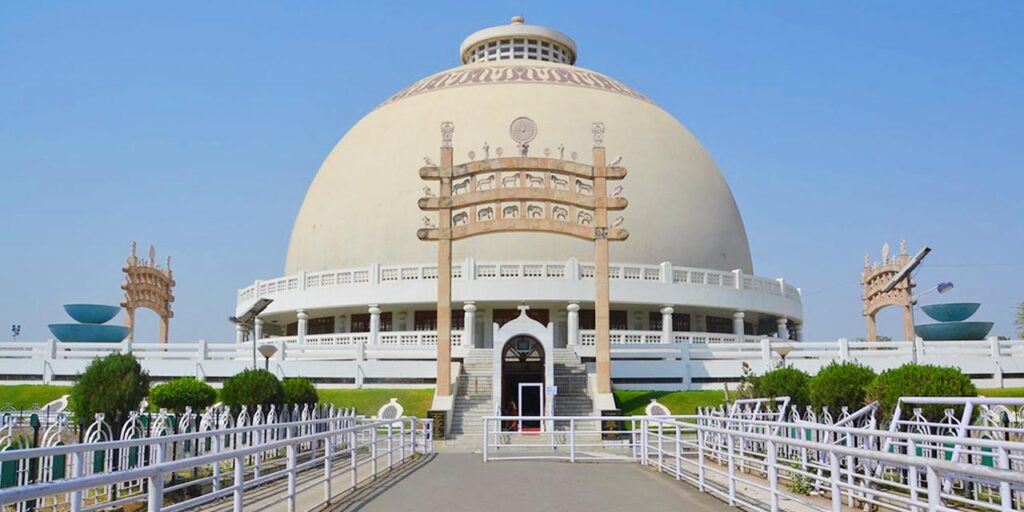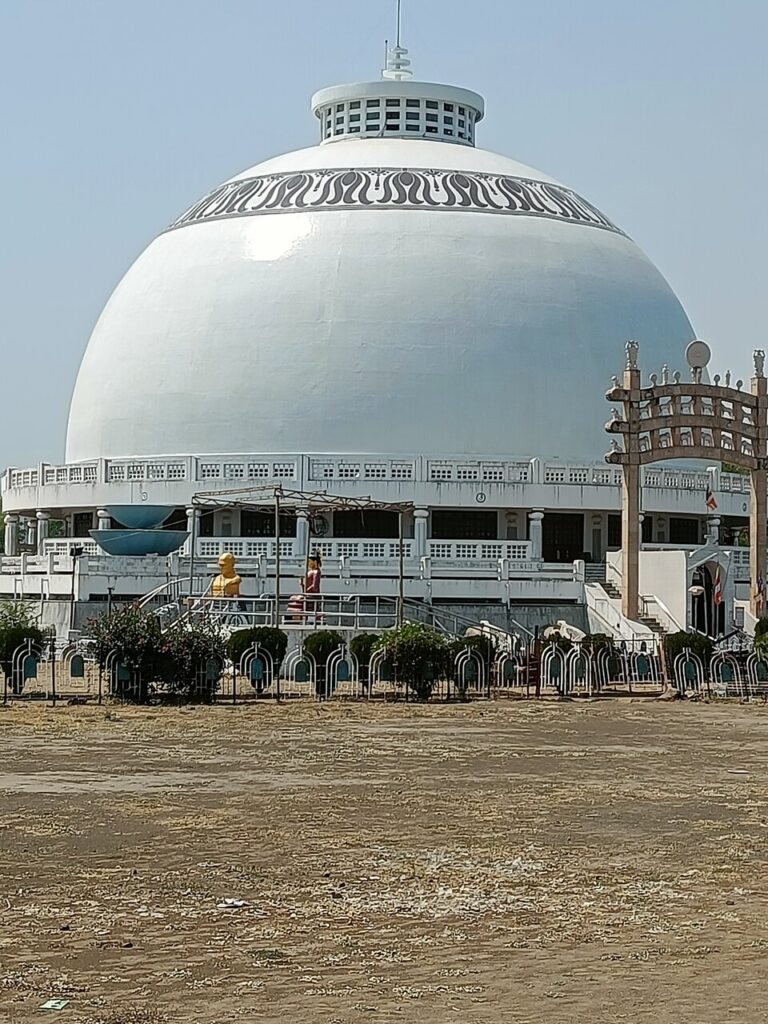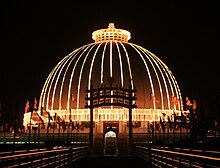Deeksha Bhoomi, Nagpur: A Sacred Landmark of Buddhist Revival in India
Introduction

Deeksha Bhoomi, located in Nagpur, Maharashtra, is one of the most significant Buddhist sites in India and a landmark of social and spiritual transformation. This sacred place holds immense historical, cultural, and religious importance, symbolizing the revival of Buddhism in modern India. The term “Deeksha” means “initiation” or “conversion,” and “Bhoomi” means “land,” signifying the hallowed ground where one of the largest mass conversions in history took place.
On October 14, 1956, Dr. B.R. Ambedkar, the chief architect of the Indian Constitution and a staunch advocate for social justice and equality, embraced Buddhism at Deeksha Bhoomi, along with over half a million followers. This monumental event marked the formal beginning of the Dalit Buddhist Movement (Navayana Buddhism), a movement that sought to reject caste-based oppression and promote human dignity, liberty, and fraternity. Ambedkar’s decision to convert was not merely a religious act but a powerful socio-political statement against the deep-rooted caste discrimination prevalent in Indian society.
The significance of Deeksha Bhoomi extends beyond its historical moment. It continues to serve as a symbol of hope, equality, and enlightenment, drawing millions of pilgrims, scholars, and social reformers from across India and around the world. Every year on October 14, thousands of devotees gather at Deeksha Bhoomi to commemorate Ambedkar’s conversion and reaffirm their commitment to the values of compassion, non-violence, and equality that Buddhism upholds.
The site is also home to a stunning stupa, one of the largest in Asia, built to honor the legacy of Ambedkar and the transformative impact of his movement. The architecture of Deeksha Bhoomi reflects Buddhist ideals, with its grand dome symbolizing peace, wisdom, and liberation. It stands as a reminder of the power of faith and social reform, inspiring generations to fight for justice and equality.
Today, Deeksha Bhoomi is not only a revered Buddhist pilgrimage site but also a center for research, cultural exchange, and human rights advocacy. It serves as a place where people from all backgrounds come to learn, reflect, and draw inspiration from the life and teachings of Dr. B.R. Ambedkar and Gautama Buddha. The legacy of Deeksha Bhoomi continues to resonate, making it a living testament to the ongoing struggle for dignity and social justice in India.

Architectural Marvel of Deeksha Bhoomi
Deeksha Bhoomi, located in Nagpur, Maharashtra, is a monument of immense historical and architectural significance. It is the site where Dr. B.R. Ambedkar and his followers embraced Buddhism on October 14, 1956, marking one of the most significant mass conversions in history. The architectural grandeur of Deeksha Bhoomi reflects the values of peace, enlightenment, and equality that Buddhism represents.
The Grand Stupa: A Symbol of Peace and Enlightenment
The central attraction of Deeksha Bhoomi is its massive white stupa, modeled after the Sanchi Stupa, one of the oldest Buddhist structures in India. This magnificent hollow dome-shaped structure, designed by architect Sheo Dan Mal, serves as a symbol of Buddhism’s core principles—wisdom, morality, and meditation.
- The stupa is constructed using reinforced concrete and marble, giving it a majestic and serene appearance.
- It is one of the largest hollow stupas in the world, allowing visitors to step inside and experience its tranquil ambiance.
- The interior houses a spacious meditation hall, where devotees and visitors can engage in silent contemplation and prayer.
Other Architectural Highlights
Besides the grand stupa, the Deeksha Bhoomi complex includes:
- Bodhi Tree – A sacred Bodhi tree (a descendant of the original tree in Bodh Gaya) has been planted within the complex, symbolizing Buddha’s enlightenment.
- Library and Research Center – Deeksha Bhoomi houses a well-equipped library and a research center dedicated to studying Buddhism, Dr. Ambedkar’s teachings, and Dalit history. Scholars, researchers, and visitors can access a vast collection of books and manuscripts.
- Dr. Ambedkar Museum – A small museum on-site showcases rare photographs, artifacts, and writings related to Dr. Ambedkar’s life, his journey toward Buddhism, and his social reform movements.
- Ambedkar Statue and Memorial Pillars – The complex features statues of Dr. Ambedkar, along with memorial pillars engraved with significant quotes from Buddhist scriptures and Ambedkar’s speeches.
A Pilgrimage Site for Millions
Deeksha Bhoomi has evolved into a major pilgrimage site for Buddhists and followers of Dr. Ambedkar’s ideology. Every year, on October 14, millions of people from India and around the world visit this sacred site to commemorate the anniversary of the Dhamma Chakra Pravartan (conversion to Buddhism). The site continues to inspire visitors with its architectural splendor and historical significance, serving as a beacon of social justice, equality, and enlightenment.

Celebrations and Events at Deekshabhoomi
Deekshabhoomi, located in Nagpur, Maharashtra, is one of the most significant pilgrimage sites for Buddhists in India. It holds immense historical and cultural importance as the place where Dr. B.R. Ambedkar and his followers embraced Buddhism on October 14, 1956, in a mass conversion ceremony known as Dhamma Chakra Pravartan Din. Every year, this occasion is marked with grand celebrations, attracting devotees and followers of Ambedkarite Buddhism from across India and abroad.
Dhamma Chakra Pravartan Din (October 14)
The most significant annual event at Deekshabhoomi is Dhamma Chakra Pravartan Din, which commemorates Dr. Ambedkar’s historic conversion to Buddhism along with nearly 500,000 followers. This day symbolizes a break from caste oppression and the adoption of Buddhist principles of equality, non-violence, and rationalism.
On this occasion, Deekshabhoomi witnesses:
- Mass gatherings of devotees, monks, and scholars from across India and foreign countries, including Sri Lanka, Thailand, Myanmar, and Japan.
- Prayer meetings and recitations of Buddhist scriptures like the Dhammapada and Tripitaka.
- Dhamma discourses, where Buddhist monks and scholars discuss Ambedkar’s interpretation of Buddhism and its relevance today.
- Cultural programs, including traditional Buddhist chants, music, and plays depicting Ambedkar’s life and his role in the social revolution.
- Mass conversions, where people formally embrace Buddhism, following the same 22 vows taken by Ambedkar in 1956.
Authorities and local organizations ensure arrangements for the large influx of pilgrims, providing food, medical aid, and accommodation. The event also attracts political leaders, social activists, and Buddhist organizations, who pay homage to Dr. Ambedkar’s legacy.
Other Annual Celebrations
Apart from Dhamma Chakra Pravartan Din, several other important events are observed at Deekshabhoomi throughout the year:
-
Ambedkar Jayanti (April 14)
- Celebrated to mark the birth anniversary of Dr. B.R. Ambedkar.
- Devotees gather to pay tribute to his contributions to social justice, equality, and the drafting of the Indian Constitution.
- Rallies, discussions, and special prayer meetings are organized.
-
Buddha Purnima (April/May, on the full moon day)
- Celebrates the birth, enlightenment, and Parinirvana of Gautama Buddha.
- Special chanting sessions and Dhamma talks are conducted by Buddhist monks.
- Thousands of devotees light lamps and offer flowers at the stupa as a mark of reverence.
-
Ashoka Vijaya Dashami
- Observed on the same day as Dussehra, this day marks Emperor Ashoka’s conversion to Buddhism after the Kalinga War.
- Processions and discussions on Ashoka’s role in spreading Buddhism globally.
International Recognition and Pilgrimage
Deekshabhoomi has grown into an international Buddhist pilgrimage site, attracting visitors from Sri Lanka, Thailand, Japan, Myanmar, and other Buddhist countries. Several international Buddhist delegations visit the site to honor Dr. Ambedkar’s contributions to modern Buddhism.
Legacy of Deekshabhoomi
Through these celebrations and events, Deekshabhoomi continues to serve as a symbol of equality, social justice, and the revival of Buddhism in India. It remains a sacred space where people come together to reflect on Ambedkar’s vision and to reaffirm their commitment to the principles of liberty, fraternity, and human dignity.
How to Reach Deeksha Bhoomi
Deeksha Bhoomi, located in Nagpur, Maharashtra, is a major pilgrimage site and a landmark of historical significance. The city of Nagpur is well-connected by road, rail, and air, making it easily accessible for visitors from across India and abroad.
By Air
Deeksha Bhoomi is located approximately 7 km from Dr. Babasaheb Ambedkar International Airport (NAG), which serves both domestic and international flights. The airport has regular flights from major Indian cities such as Delhi, Mumbai, Kolkata, Bangalore, Chennai, Pune, and Hyderabad.
- Transport Options from Airport:
- Prepaid taxis and app-based cabs (such as Ola and Uber) are available at the airport.
- Auto-rickshaws and private car rentals can also be hired for a convenient journey to Deeksha Bhoomi.
By Train
Nagpur is a major railway junction, well-connected to various parts of India via the Central and South East Central Railway zones. The nearest railway station is Nagpur Railway Station, located around 6 km from Deeksha Bhoomi.
-
Major trains passing through Nagpur include:
- Rajdhani Express (Delhi – Mumbai route)
- Duronto Express
- Shatabdi Express
- Garib Rath Express
- Gitanjali Express
-
Transport Options from Nagpur Railway Station:
- City buses run by the Nagpur Municipal Corporation connect the railway station to Deeksha Bhoomi.
- Auto-rickshaws and taxis are available for a direct and comfortable ride to the site.
By Road
Nagpur is well connected to the rest of India via National Highways NH-44, NH-53, and NH-47. Several state-run and private bus services operate between Nagpur and major cities such as Mumbai, Pune, Hyderabad, Bhopal, Indore, and Raipur.
- Nagpur Bus Stand:
- The Maharashtra State Road Transport Corporation (MSRTC) bus terminal and private bus stands are located around 5-7 km from Deeksha Bhoomi.
- Local buses, taxis, and auto-rickshaws provide easy connectivity to the site.
Local Transport in Nagpur
Once in Nagpur, visitors can reach Deeksha Bhoomi through various local transport options:
- City Buses: Affordable and frequent bus services run across the city, connecting Deeksha Bhoomi to major landmarks.
- Auto-Rickshaws: Easily available for short distances; fares can be negotiated.
- App-Based Cabs: Ola, Uber, and other ride-hailing services offer a convenient mode of transport.
- Rental Vehicles: Private cars and two-wheelers can be rented for flexibility in exploring the city.
Best Time to Visit
The best time to visit Deeksha Bhoomi is between October and March, when the weather is pleasant. The most significant time to visit is on October 14, when millions gather for the Dhamma Chakra Pravartan Day celebrations.
Deeksha Bhoomi is not only an architectural marvel but also a symbol of social transformation and equality, making it a must-visit destination for history enthusiasts, followers of Buddhism, and admirers of Dr. B.R. Ambedkar.
For More Info You Can Visit Here .
Want to read more articles like this? Explore now!






Trackbacks/Pingbacks